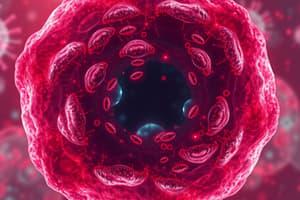Podcast
Questions and Answers
Which immunoglobulin type is most commonly overproduced in Multiple Myeloma?
Which immunoglobulin type is most commonly overproduced in Multiple Myeloma?
- IgM
- IgA
- IgD
- IgG (correct)
Which condition is characterized by >10% monoclonal B lymphocytes in a bone marrow biopsy?
Which condition is characterized by >10% monoclonal B lymphocytes in a bone marrow biopsy?
- Multiple Myeloma
- Chronic Lymphocytic Leukemia
- Waldenström Macroglobulinemia (correct)
- Monoclonal Gammopathy of Undetermined Significance
What is the primary complication associated with Multiple Myeloma?
What is the primary complication associated with Multiple Myeloma?
- Hyperviscosity syndrome
- Secondary hypertension
- Cerebrovascular accident
- Increased infection risk (correct)
What distinctive finding is associated with the peripheral blood smear in patients with Plasma Cell Dyscrasias?
What distinctive finding is associated with the peripheral blood smear in patients with Plasma Cell Dyscrasias?
What is the most relevant laboratory test for confirming urinary involvement in Plasma Cell Dyscrasias?
What is the most relevant laboratory test for confirming urinary involvement in Plasma Cell Dyscrasias?
Which clinical feature is primarily associated with Waldenström Macroglobulinemia?
Which clinical feature is primarily associated with Waldenström Macroglobulinemia?
What laboratory finding is indicative of Multiple Myeloma during urinalysis?
What laboratory finding is indicative of Multiple Myeloma during urinalysis?
Which of the following findings in a bone marrow biopsy confirms a diagnosis of Multiple Myeloma?
Which of the following findings in a bone marrow biopsy confirms a diagnosis of Multiple Myeloma?
What symptom is typically absent in Multiple Myeloma compared to Waldenström Macroglobulinemia?
What symptom is typically absent in Multiple Myeloma compared to Waldenström Macroglobulinemia?
What is the main risk factor for progressing from Monoclonal Gammopathy of Undetermined Significance to Multiple Myeloma?
What is the main risk factor for progressing from Monoclonal Gammopathy of Undetermined Significance to Multiple Myeloma?
Which condition is associated with hyperviscosity symptoms such as headache and blurry vision?
Which condition is associated with hyperviscosity symptoms such as headache and blurry vision?
Which component is most commonly produced in Multiple Myeloma?
Which component is most commonly produced in Multiple Myeloma?
What is a common clinical sign indicated by the acronym CRAB in Multiple Myeloma?
What is a common clinical sign indicated by the acronym CRAB in Multiple Myeloma?
Which laboratory finding is typically used to confirm urinary involvement in Plasma Cell Dyscrasias?
Which laboratory finding is typically used to confirm urinary involvement in Plasma Cell Dyscrasias?
Which of the following features is a definitive diagnostic indicator for Waldenström Macroglobulinemia upon biopsy?
Which of the following features is a definitive diagnostic indicator for Waldenström Macroglobulinemia upon biopsy?
What is a common clinical manifestation associated with Waldenström Macroglobulinemia?
What is a common clinical manifestation associated with Waldenström Macroglobulinemia?
Which finding is indicative of Multiple Myeloma in a bone marrow biopsy?
Which finding is indicative of Multiple Myeloma in a bone marrow biopsy?
What complication is particularly associated with Multiple Myeloma?
What complication is particularly associated with Multiple Myeloma?
What distinctive laboratory finding is associated with urine in Multiple Myeloma?
What distinctive laboratory finding is associated with urine in Multiple Myeloma?
Which of the following characteristics is seen in the peripheral blood smear of Plasma Cell Dyscrasias?
Which of the following characteristics is seen in the peripheral blood smear of Plasma Cell Dyscrasias?
Which of the following findings is common in Multiple Myeloma due to increased osteoclast activity?
Which of the following findings is common in Multiple Myeloma due to increased osteoclast activity?
What is a key diagnostic feature observed during fundoscopy in patients with Waldenström Macroglobulinemia?
What is a key diagnostic feature observed during fundoscopy in patients with Waldenström Macroglobulinemia?
Which laboratory test is crucial for confirming renal involvement in Plasma Cell Dyscrasias?
Which laboratory test is crucial for confirming renal involvement in Plasma Cell Dyscrasias?
Which of the following complications is specifically associated with Multiple Myeloma?
Which of the following complications is specifically associated with Multiple Myeloma?
In waldenström Macroglobulinemia, what key clinical symptom may indicate hyperviscosity?
In waldenström Macroglobulinemia, what key clinical symptom may indicate hyperviscosity?
What is a potential complication of Multiple Myeloma affecting patient health?
What is a potential complication of Multiple Myeloma affecting patient health?
Which feature on a bone marrow biopsy is indicative of Waldenström Macroglobulinemia?
Which feature on a bone marrow biopsy is indicative of Waldenström Macroglobulinemia?
Which of the following clinical symptoms is associated with hyperviscosity in Waldenström Macroglobulinemia?
Which of the following clinical symptoms is associated with hyperviscosity in Waldenström Macroglobulinemia?
In which condition would you typically observe rouleaux formation in a peripheral blood smear?
In which condition would you typically observe rouleaux formation in a peripheral blood smear?
Which immunoglobulin is primarily overproduced in Waldenström Macroglobulinemia?
Which immunoglobulin is primarily overproduced in Waldenström Macroglobulinemia?
Flashcards are hidden until you start studying
Study Notes
Plasma Cell Dyscrasias
- Disorders marked by proliferation of a single plasma cell clone producing a monoclonal immunoglobulin, also known as paraprotein.
- Commonly observed in older adults.
- Screening methods include serum protein electrophoresis (M spike indicates monoclonal Ig overproduction), serum immunofixation, and serum free light chain assay.
- Urine protein electrophoresis and immunofixation are necessary for confirming urine involvement; urine dipstick only detects albumin.
- Bone marrow biopsy is crucial for diagnostic confirmation.
- Peripheral blood smear may reveal rouleaux formation, where red blood cells appear stacked like poker chips.
Multiple Myeloma
- Characterized by the overproduction of IgG (most prevalent), followed by IgA and Ig light chains.
- Clinical features encapsulated by the acronym CRAB:
- Calcium elevation due to increased cytokine secretion (e.g., IL-1, TNF-α, RANK-L) from malignant plasma cells, stimulating osteoclast activity.
- Renal insufficiency.
- Anemia.
- Bone lytic lesions, often described as "punched out" on X-ray, frequently causing back pain.
- Complications include heightened infection risk and primary amyloidosis (AL).
- Diagnosis involves urinalysis identifying Ig light chains (Bence Jones proteinuria) using θ urine dipstick.
- Bone marrow biopsy findings include:
- More than 10% monoclonal plasma cells featuring clock-face chromatin.
- Intracytoplasmic inclusions containing immunoglobulin.
Waldenström Macroglobulinemia
- Defined by overproduction of IgM, leading to macroglobulinemia as IgM is the largest immunoglobulin.
- Clinical manifestations include:
- Anemia.
- Constitutional symptoms ("B" symptoms).
- Lymphadenopathy.
- Hepatosplenomegaly.
- Hyperviscosity causing symptoms like headache, bleeding, blurry vision, and ataxia.
- Peripheral neuropathy.
- Diagnosis through fundoscopy reveals dilated, segmented, and tortuous retinal veins, resembling sausage links.
- Bone marrow biopsy characteristics:
- More than 10% monoclonal B lymphocytes.
- Features of plasma cells (lymphoplasmacytic lymphoma).
- Intranuclear pseudoinclusions containing IgM.
Monoclonal Gammopathy of Undetermined Significance
- Characterized by the overproduction of any immunoglobulin type, typically indicated by the presence of an M spike.
Plasma Cell Dyscrasias
- Disorders result from the proliferation of a single plasma cell clone producing monoclonal immunoglobulin (paraprotein).
- Primarily affects older adults.
- Screening involves:
- Serum protein electrophoresis (identifies M spike for monoclonal Ig overproduction).
- Serum immunofixation and serum free light chain assay.
- Urine protein electrophoresis and immunofixation used to confirm urinary involvement (urine dipstick is insufficient as it only detects albumin).
- Bone marrow biopsy is necessary for diagnostic confirmation.
- Peripheral blood smear may exhibit rouleaux formation, resembling stacked poker chips.
Multiple Myeloma
- Characterized by the overproduction of IgG (most common), followed by IgA and Ig light chains.
- Clinical features summarized as CRAB:
- Calcium elevation (hypercalcemia) due to cytokine secretion by malignant plasma cells, promoting osteoclast activity.
- Renal insufficiency resulting from hypercalcemia and potential nephrotoxic effects.
- Anemia linked to bone marrow infiltration.
- Bone lytic lesions appearing “punched out” on x-ray, leading to back pain.
- Complications include increased risk of infections and primary amyloidosis (AL type).
- Diagnosis methods:
- Urinalysis reveals Ig light chains (Bence Jones proteinuria) using urine dipstick.
- Bone marrow biopsy shows:
- Over 10% monoclonal plasma cells with clock-face chromatin.
- Intracytoplasmic inclusions containing immunoglobulin.
Waldenström Macroglobulinemia
- Characterized by the overproduction of IgM, the largest immunoglobulin, leading to macroglobulinemia.
- Clinical features include:
- Anemia and constitutional ("B") signs/symptoms (fever, weight loss, night sweats).
- Lymphadenopathy and hepatosplenomegaly.
- Hyperviscosity syndrome resulting in headaches, bleeding, blurry vision, and ataxia.
- Peripheral neuropathy due to IgM levels.
- Diagnosis methods:
- Fundoscopy may reveal dilated, segmented, and tortuous retinal veins with a sausage link appearance.
- Bone marrow biopsy shows:
- Over 10% monoclonal B lymphocytes.
- Plasma cell features indicating lymphoplasmacytic lymphoma.
- Intranuclear pseudoinclusions containing IgM.
Monoclonal Gammopathy of Undetermined Significance (MGUS)
- Represents overproduction of any immunoglobulin type.
- Often identified by the presence of an M spike in serum protein electrophoresis.
Plasma Cell Dyscrasias
- Characterized by the proliferation of a single plasma cell clone resulting in the overproduction of monoclonal immunoglobulin (paraprotein).
- Commonly affects older adults.
- Screening methods include serum protein electrophoresis (M spike indicates monoclonal Ig), serum immunofixation, and serum free light chain assay.
- To confirm urinary involvement, use urine protein electrophoresis and immunofixation as urine dipstick primarily detects albumin.
- Diagnostic confirmation requires a bone marrow biopsy.
- Peripheral blood smear may reveal rouleaux formation, where RBCs stack like poker chips.
Multiple Myeloma
- Most frequently associated with the overproduction of IgG, followed by IgA and Ig light chains.
Clinical Features (CRAB):
- Hypercalcemia due to increased cytokine secretion (e.g., IL-1, TNF-a, RANK-L) promoting osteoclast activity.
- Renal insufficiency as a complication.
- Anemia common in presentation.
- Bone lytic lesions appear "punched out" on X-ray, often causing back pain.
Complications:
- Increased risk of infections.
- Primary amyloidosis (AL) may occur.
Diagnosis:
- Urinalysis reveals Ig light chains (Bence Jones proteinuria) and results from urine dipstick.
- Bone marrow biopsy shows >10% monoclonal plasma cells, characterized by clock-face chromatin and intracytoplasmic Ig inclusions.
Waldenström Macroglobulinemia
- Characterized by an overproduction of IgM, the largest immunoglobulin, leading to macroglobulinemia.
Clinical Features:
- Anemia is commonly observed.
- Common "B" signs and symptoms include fatigue and unintentional weight loss.
- Lymphadenopathy (swollen lymph nodes) is frequent.
- Hepatosplenomegaly (enlargement of liver and spleen) may occur.
- Hyperviscosity symptoms include headaches, bleeding, blurry vision, and ataxia (loss of full control of bodily movements).
- Peripheral neuropathy may develop.
Diagnosis:
- Fundoscopy typically shows dilated, segmented, and tortuous retinal veins, resembling a "sausage link" appearance.
- Bone marrow biopsy reveals >10% monoclonal B lymphocytes with plasma cell features indicative of lymphoplasmacytic lymphoma and intranuclear pseudoinclusions containing IgM.
Monoclonal Gammopathy of Undetermined Significance
- Involves overproduction of any type of immunoglobulin, identifiable by the presence of an M spike.
Plasma Cell Dyscrasias
- Characterized by proliferation of a single plasma cell clone, resulting in overproduction of a monoclonal immunoglobulin (paraprotein).
- Primarily affects older adults.
- Diagnostic tools include serum protein electrophoresis (M spike indicates monoclonal immunoglobulin), serum immunofixation, and serum free light chain assay.
- Urine protein electrophoresis and immunofixation required to assess urinary involvement; urine dipstick detects only albumin.
- Bone marrow biopsy is crucial for diagnostic confirmation.
- Peripheral blood smear may reveal rouleaux formation, where red blood cells stack like poker chips.
Multiple Myeloma
- Most commonly involves overproduction of IgG, followed by IgA and Ig light chains.
- Clinical features encapsulated by CRAB:
- Hypercalcemia caused by cytokine secretion (IL-1, TNF-α, RANK-L) from malignant plasma cells, enhancing osteoclast activity.
- Renal insufficiency due to deposition of light chains.
- Anemia leading to fatigue and complications.
- Bone lytic lesions visible as "punched-out" areas on X-ray, often causing back pain.
- Complications include increased risk of infections and primary amyloidosis (AL type).
- Diagnostic criteria include:
- Urinalysis revealing Bence Jones proteinuria (Ig light chains).
- Bone marrow biopsy showing over 10% monoclonal plasma cells with clock-face chromatin and intracytoplasmic Ig inclusions.
Waldenström Macroglobulinemia
- Features overproduction of IgM, the largest immunoglobulin, causing macroglobulinemia.
- Clinical symptoms include:
- Anemia and constitutional ("B") signs such as fever, night sweats, and weight loss.
- Lymphadenopathy and hepatosplenomegaly.
- Hyperviscosity symptoms like headache, bleeding, blurred vision, and ataxia.
- Peripheral neuropathy.
- Diagnosis involves:
- Fundoscopy revealing dilated, segmented, and tortuous retinal veins (sausage link appearance).
- Bone marrow biopsy indicating more than 10% monoclonal B lymphocytes, plasma cell features, and intranuclear pseudoinclusions containing IgM.
Monoclonal Gammopathy of Undetermined Significance
- Involves the overproduction of any type of immunoglobulin, identifiable through the presence of an M spike.
Plasma Cell Dyscrasias
- Characterized by proliferation of a single plasma cell clone leading to monoclonal immunoglobulin overproduction (paraprotein).
- Typically affects older adults.
- Screening performed with serum protein electrophoresis, where M spike indicates monoclonal Ig overproduction.
- Additional tests include serum immunofixation and serum free light chain assay.
- Urine protein electrophoresis and immunofixation confirm urinary involvement; urine dipstick detects only albumin.
- Diagnosis confirmed through bone marrow biopsy.
- Peripheral blood smear may show rouleaux formation, indicating stacked red blood cells.
Multiple Myeloma
- Most common type overproduces IgG, followed by IgA and light chains.
Clinical Features (CRAB)
- Hypercalcemia due to increased cytokine secretion (IL-1, TNF-a, RANK-L) by malignant plasma cells, enhancing osteoclast activity.
- Renal insufficiency connected to high levels of paraprotein.
- Anemia resulting from decreased erythrocyte production.
- Bone lytic lesions observed as "punched out" areas on X-rays, commonly causing back pain.
Complications
- Increased susceptibility to infections due to immune system compromise.
- Possible development of primary amyloidosis (AL type).
Diagnosis
- Urinalysis detects immunoglobulin light chains, termed Bence Jones proteinuria, via urine dipstick.
- Bone marrow biopsy reveals more than 10% monoclonal plasma cells with clock-face chromatin and intracytoplasmic inclusions containing Ig.
Waldenström Macroglobulinemia
- Characterized by overproduction of IgM, the largest immunoglobulin, resulting in macroglobulinemia.
Clinical Features
- Anemia presents with fatigue and weakness.
- Constitutional symptoms include fever, night sweats, and weight loss.
- Lymphadenopathy and hepatosplenomegaly are common findings.
- Hyperviscosity leads to headaches, bleeding, visual disturbances, and ataxia.
- Peripheral neuropathy may occur, affecting sensation and motor function.
Diagnosis
- Fundoscopy shows dilated, segmented, and tortuous retinal veins, resembling sausage links.
- Bone marrow biopsy indicates over 10% monoclonal B lymphocytes with plasma cell features, consistent with lymphoplasmacytic lymphoma, and intranuclear pseudoinclusions containing IgM.
Monoclonal Gammopathy of Undetermined Significance (MGUS)
- Defined by overproduction of any immunoglobulin type, indicated by the presence of an M spike.
Plasma Cell Dyscrasias
- A group of disorders caused by the proliferation of a single plasma cell clone.
- Typically involves the overproduction of monoclonal immunoglobulin (paraprotein).
- Commonly observed in older adults.
- Screening tests include serum protein electrophoresis (detects M spike), serum immunofixation, and serum free light chain assay.
- Confirmation of urinary involvement requires urine protein electrophoresis and immunofixation; urine dipstick can only detect albumin.
- Diagnostic confirmation is achieved through bone marrow biopsy.
- Peripheral blood smear may reveal rouleaux formation, where RBCs appear stacked like poker chips.
Multiple Myeloma
- Characterized by excessive production of IgG (most common), followed by IgA and Ig light chains.
- Clinical features represented by the acronym CRAB:
- Calcium elevated (hypercalcemia) due to cytokine secretion from malignant plasma cells, leading to increased osteoclast activity.
- Renal insufficiency as a consequence of heavy protein loads.
- Anemia resulting from bone marrow infiltration.
- Bone lytic lesions, identifiable as "punched-out" areas on X-ray, often causing back pain.
- Complications include increased susceptibility to infections and primary amyloidosis (AL).
- Diagnosis involves:
- Urinalysis: Shows presence of Ig light chains (Bence Jones protein).
- Bone Marrow Biopsy: Must show over 10% monoclonal plasma cells with clock-face chromatin and intracytoplasmic inclusions containing Ig.
Waldenström Macroglobulinemia
- Involves overproduction of IgM, noted for being the largest immunoglobulin, leading to macroglobulinemia.
- Clinical features include:
- Anemia and constitutional symptoms (B symptoms like fever, night sweats).
- Lymphadenopathy and hepatosplenomegaly.
- Symptoms related to hyperviscosity, such as headaches, bleeding, blurry vision, and ataxia.
- Peripheral neuropathy.
- Diagnosis includes:
- Fundoscopy: Observes dilated, segmented, and tortuous retinal veins, noted for appearing like "sausage links."
- Bone Marrow Biopsy: Must show greater than 10% monoclonal B lymphocytes with plasma cell characteristics (lymphoplasmacytic lymphoma) and intranuclear pseudoinclusions containing IgM.
Monoclonal Gammopathy of Undetermined Significance
- Involves the overproduction of any type of immunoglobulin, characterized by an identified M spike.
Studying That Suits You
Use AI to generate personalized quizzes and flashcards to suit your learning preferences.




